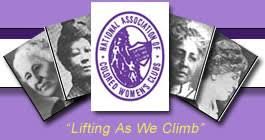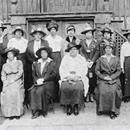
The National Association of Colored Women Clubs (NACWC) is an American organization that was formed in July 1896 at the First Annual Convention of the National Federation of Afro-American Women in Washington, D.C., United States, by a merger of the National Federation of African-American Women, the Woman’s Era Club of Boston, and the National League of Colored Women of Washington, DC, at the call of Josephine St. Pierre Ruffin. From 1896 to 1904 it was known as the National Association of Colored Women (NACW).
It adopted the motto “Lifting as we climb”, to demonstrate to “an ignorant and suspicious world that our aims and interests are identical with those of all good aspiring women.” When incorporated in 1904, NACW became known as the National Association of Colored Women’s Clubs (NACWC)
This first of what would later become biennial convention meetings of the association was held at the Nineteenth Street Baptist Church.
The organizations attending this convention included the National Federation of Afro-American Women, the Women’s Era Club of Boston, and the National League of Colored Women of Washington, DC, the Women’s Loyal Union as well as smaller organizations that had arisen from the African-American women’s club movement.
These organizations and later others across the country merged to form the National Association of Colored Women. The organization helped all African-American women by working on issues of civil rights and injustice, such as women’s suffrage, lynching, and Jim Crow laws.
Founders of the NACWC included Harriet Tubman, Margaret Murray Washington, Frances E.W. Harper, Ida Bell Wells-Barnett, and Mary Church Terrell. Its two leading members were Josephine St. Pierre Ruffin and Mary Church Terrell.
Their original intention was “to furnish evidence of the moral, mental and material progress made by people of color through the efforts of our women”.
They organized to refute a letter written by James Jacks, the president of the Missouri Press Association, challenging the respectability of African-American women, and referring to them as thieves and prostitutes.
During the next ten years, the NACWC became involved in campaigns in favor of women’s suffrage and against lynching and Jim Crow laws. They also led efforts to improve education, and care for both children and the elderly. By 1918, when the United States entered the First World War, membership in the NACWC had grown to an extraordinary 300,000 nationwide.
That the National Association of Colored Women was the most prominent organization formed during the African-American Woman Suffrage Movement was due chiefly to the efforts of Josephine St. Pierre Ruffin and Mary Church Terrell. Both women were educated and had economically successful parents.
Born on August 31, 1842, in Boston, Josephine St. Pierre was the daughter of John St. Pierre, a successful clothes dealer from Martinique and Elizabeth Matilda Menhenick from Cornwall, England. Her parents supported her going to school in Salem for its integrated schools, rather than attend segregated ones in Boston.
There Josephine St. Pierre flourished. At the age of 16, she married George Lewis Ruffin, who became the first African-American graduate of Harvard Law School. Among their early activities was recruiting black soldiers for the Union Army during the Civil War.
After her husband died in 1886, Josephine St. Pierre Ruffin used part of her estate to fund Woman’s Era, the first journal published by and for African-American women. She was a vice-president of the National Association of Colored Women. In 1910 Ruffin enlarged her social activism by helping form the National Association for the Advancement of Colored People (NAACP). She died in March 1924.
Mary Church Terrell was the daughter of Robert Church, Sr., a former slave and reputed son of a white master. Church, Sr. built a business and became one of the wealthiest black men in the South.
He was able to send Mary to Oberlin College, where she earned both bachelor’s and master’s degrees. Years later Mary Church Terrell spoke at the Berlin International Congress of Women, giving her speech in fluent German and French, as well as English. She was the only black woman at the conference.
Terrell was elected as the first president of the National Association of Colored Women in 1896. She led the struggle in Washington, DC against segregation in public eating places and succeeded in winning a court decision for integration there. Terrell died in Annapolis, Maryland, on July 24, 1954.




